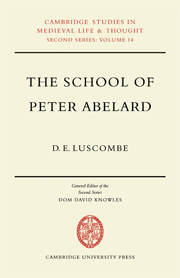Book contents
- Frontmatter
- Contents
- Preface
- List of Abbreviations
- I The Literary Evidence
- II Abelard's Followers
- III The Diffusion of Abelardian Writings
- IV The Condemnation of 1140
- V The Theological Writings of Abelard's Closest Disciples
- VI The School of Laon
- VII Hugh of St Victor
- VIII The Summa Sententiarum
- IX Abelard and the Decretum of Gratian
- X Abelard's Disciples and the School of St Victor
- XI Peter Lombard
- XII Robert of Melun
- XIII Richard of St Victor
- XIV Conclusion
- Appendices
- Bibliography
- Index of Manuscripts
- General Index
IX - Abelard and the Decretum of Gratian
Published online by Cambridge University Press: 05 November 2011
- Frontmatter
- Contents
- Preface
- List of Abbreviations
- I The Literary Evidence
- II Abelard's Followers
- III The Diffusion of Abelardian Writings
- IV The Condemnation of 1140
- V The Theological Writings of Abelard's Closest Disciples
- VI The School of Laon
- VII Hugh of St Victor
- VIII The Summa Sententiarum
- IX Abelard and the Decretum of Gratian
- X Abelard's Disciples and the School of St Victor
- XI Peter Lombard
- XII Robert of Melun
- XIII Richard of St Victor
- XIV Conclusion
- Appendices
- Bibliography
- Index of Manuscripts
- General Index
Summary
In his Decretum Gratian not only utilized previous canonical collections but also applied hermeneutic principles in the task of reconciling the contradictions which appeared to exist in the masses of received auctoritates. The achievement of a concordia between the discordantes canones was a fundamental purpose of the Decretum; if previous canonical collectors had used rules of reconciliation to remedy the difficulties in the sources which they used, Gratian made such rules the central principle of his whole edifice. Like Gratian Abelard in his Sic et Non made the task of reconciliation the cornerstone of his work and, as S. Kuttner observed, it is a stupendous fact of medieval history that within a decade or two such a synchronism and parallelism should occur in this respect and generally too between the birth of scholastic theology in northern France and the rebirth of jurisprudence in Bologna. F. Thaner in the year 1900 went so far as to state that Gratian, particularly in the first part of the Decretum, was directly influenced by the Sic et Non of Abelard. But Thaner's thesis has usually been judged to be too absolute since Abelard was, like Gratian, himself much influenced by earlier reconcilers such as Bernold of Constance, Ivo of Chartres and Alger of Lieége.
- Type
- Chapter
- Information
- The School of Peter AbelardThe Influence of Abelard's Thought in the Early Scholastic Period, pp. 214 - 223Publisher: Cambridge University PressPrint publication year: 1969

